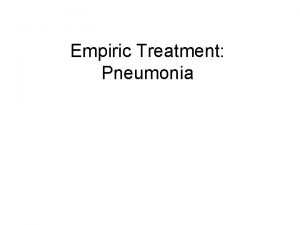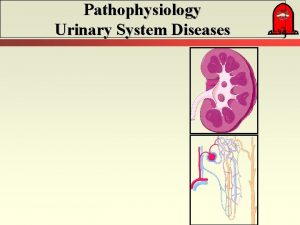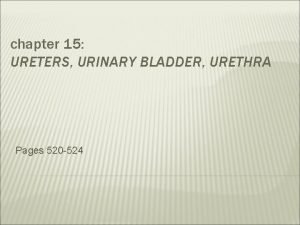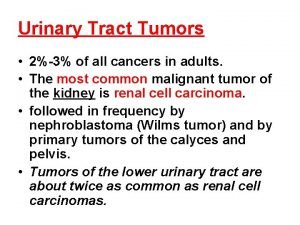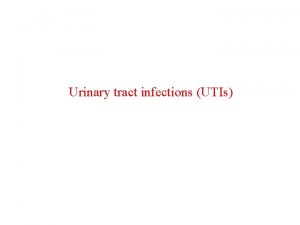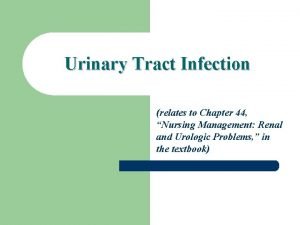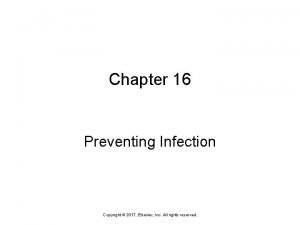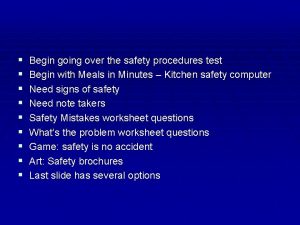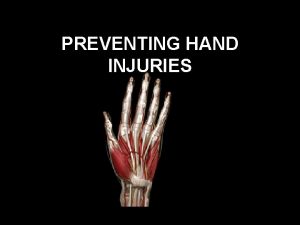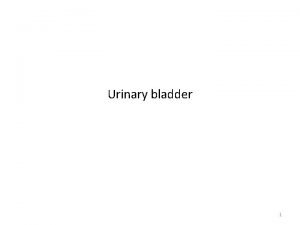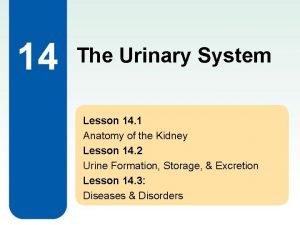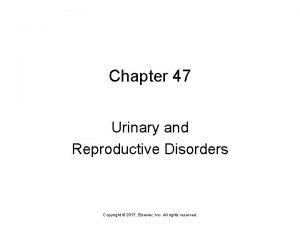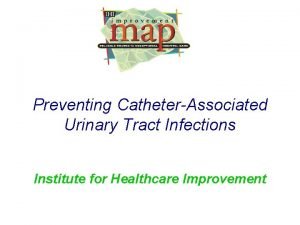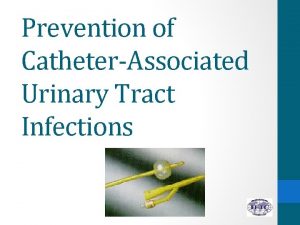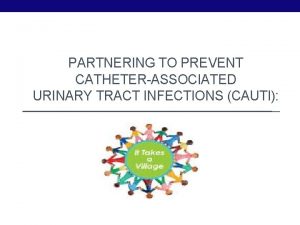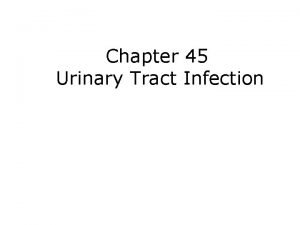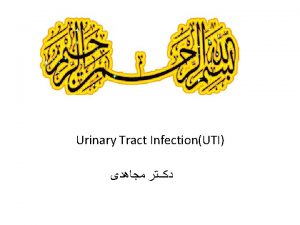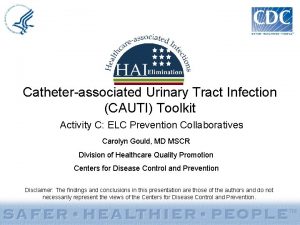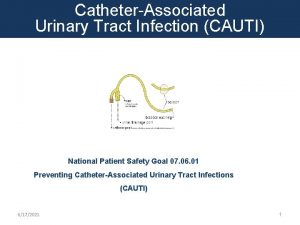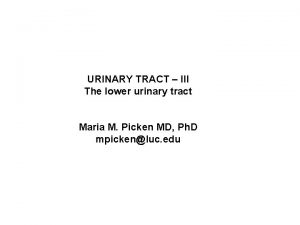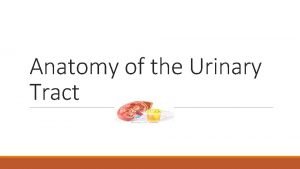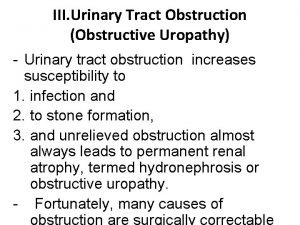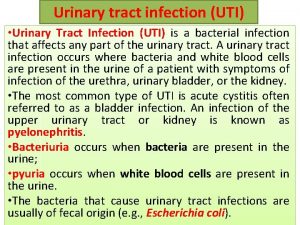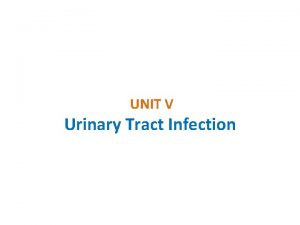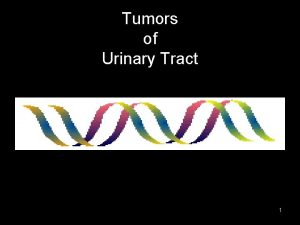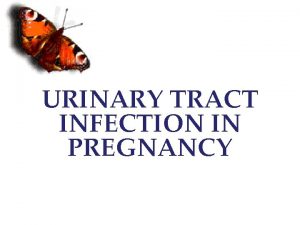Preventing CatheterAssociated Urinary Tract Infections Planning and Implementing






























































- Slides: 62

Preventing Catheter-Associated Urinary Tract Infections: Planning and Implementing the Effort Mohamad Fakih, MD, MPH Associate Professor of Medicine Wayne State University School of Medicine St John Hospital and Medical Center, Detroit, MI 9/14/12

An 82 -year-old woman was admitted for congestive heart failure… • She had a urinary catheter (UC) placed and was started on diuretics. She appeared frail. Her physician and nurses felt that keeping the catheter in place would make her more comfortable. • On the 5 th day of admission, she started complaining of chills, had a fever of 102°F, and her BP dropped to 90 systolic. Blood cultures and urine cultures grew Escherichia coli. She was diagnosed with symptomatic CAUTI and had to be treated with intravenous antibiotics. 2

A 78 -year-old nursing home resident was admitted for a gastrostomy tube change… • The ED nurse noted that he was incontinent. The male patient was confused because of long-standing dementia. Although a bladder scan did not show any urinary retention, the nurse spoke to the ED physician about placing a catheter. Several hours after the catheter was placed, the patient pulled it out, leading to a urethral injury and hematuria. • This required a urology evaluation. 3

Objectives • Epidemiology of UC use and CAUTI • How to reduce the risk of CAUTI – Proper insertion/ maintenance – Prompt removal of no longer needed catheters – Limit use to indications • • Where to intervene How to sustain improvements Engaging nurses and physicians Measuring improvements (process, outcome) 4

Epidemiology • Urinary catheters are frequently used in the hospital setting. • The presence of the indwelling urinary catheter increases the risk of urinary tract infections. 5

Urinary Catheter Utilization • About 15 - 25% of patients will have a urinary catheter placed during their hospitalization. • Many are placed either in the intensive care unit, emergency department or the operating room. 6

Mean Use of UCs (NHSN): ICU > General Wards (Edwards, Am J Infect Control 2009; 37: 783 -805, Dudeck, Am J Infect Control. 2011; 39(5): 349367; Am J Infect Control 2011; 39(10): 798 -816 ) Unit 2006 -8 Urinary Catheter Utilization Ratio 2009 Urinary Catheter Utilization Ratio 2010 Urinary Catheter Utilization Ratio ICU (med-surg, major teaching) 0. 78 0. 73 ICU (med-surg, >15 beds) 0. 79 0. 72 0. 71 General Wards (med-surg) 0. 22 0. 19 7

Inappropriate Use • 40% - 50% of patients from non-intensive medical and surgical units may not have a valid indication for urinary catheter placement. • This can occur: 1. At the time of placement 2. With continued use 8

Inappropriate Use in non-ICU: Michigan Experience 2007 -10 (Fakih et al, Arch Intern Med 2012; 172: 255 -260) Baseline % of all patients with catheters (57. 6%) % of patients with catheters without appropriate indications* Non-obstructive renal insufficiency Transferred from intensive care Patient request 2. 2 3. 8 4. 2 7. 3 1. 5 2. 6 Confusion 4. 6 8. 0 Incontinence 6. 5 11. 3 Other or no clear 38. 6 reasons *Based on the 1983 CDC recommendations 67. 0 9

Very Elderly Women Are at High Risk for Unnecessary Utilization (Fakih et al, Am J Infect Control 2010; 38: 683 -8) • Evaluated urinary catheter (UC) placement for all admissions from the emergency department (ED). • 532 (11. 8%) of 4521 patients had a UC placed. Of those, 69. 7% were indicated, and 58. 6% had a physician order documented. • Inappropriate placement: older (mean age 71. 3 vs. those with indication 60. 0 years, p<0. 0001, and patients with no UC placed 56. 2, p<0. 0001). • Half of women ≥ 80 years with a UC placed did not have an indication. • Independent factors: women were twice more likely than men, and very elderly (≥ 80 years) were 3 times more likely than those 50 or younger, to have UC placed without indication. 10

Part of the HEN work CAUTI Pressure ulcers Venous thromboembolism? Urinary Catheter Harm Immobility Falls? Increased Length of Stay Patient discomfort Trauma Isn’t this a patient safety issue, not just CAUTI? 11

Catheter-Associated UTIs (CAUTIs) (Tambyah, Infect Control Hosp Epidemiol 2002; 23: 27 -31; Saint S, Am J Infect Control 2000; 28: 68 -75 ; Dudeck, Am J Infect Control. 2011; 39(5): 349 -367) • • • Hospital-acquired bacteriuria and candiduria in 25% of those with urinary catheters placed for a week Risk of bacteriuria: about 5% per day Symptomatic UTI: 16 -32% of those bacteriuric 12

Mean CAUTI Rates: Changes with New Definition (Edwards, Am J Infect Control 2009; 37: 783 -805, Dudeck, Am J Infect Control. 2011; 39(5): 349 -367; Am J Infect Control 2011; 39(10): 798 -816 ) Unit 2006 -8 NHSN 2009 NHSN SCAUTI Rate* (per CAUTI Rate (per 1, 000 catheter days) 2010 NHSN SCAUTI Rate (per 1, 000 catheter days) ICU (med-surg, major teaching) 4. 7 2. 3 2. 2 ICU (med-surg, >15 beds) 3. 1 1. 2 1. 3 General wards (med-surg) 5. 9 1. 6 1. 5 *Prior to the new SUTI definition 13

Reducing Risk of CAUTI Limit catheter use to indications (Avoid placing the catheter unless appropriately indicated) Limit catheter use to indications (promptly remove those that are no longer necessary) Reduce urinary catheter days leading to a reduction in days at risk for CAUTI Appropriate Care of the Catheter Proper Insertion Technique Reduce risk of introducing organisms to the bladder leading to a reduction of risk of CAUTI when catheter in place 14

Proper Insertion Technique • Perform hand hygiene before and after placement. • Maintain aseptic technique and use of sterile equipment. • Use sterile gloves, drape, an antiseptic solution for periurethral cleaning, and a single packet of lubricant for insertion. • Use the appropriate catheter size. 15

Maintenance of Urinary Catheters Keep a closed system for the urinary drainage system. • Make sure urinary flow is not obstructed: 1. No kinks in the catheter. 2. Urinary bag should always be lower than the bladder. 3. Regular emptying of urinary bag. • 16

Limit Use to Indications Avoid use unless appropriate indication Promptly remove of catheter when no longer indicated Reduction in Inappropriate Urinary Catheter Use Clear Identification of what is considered an appropriate indication 17

Removal of No-Longer Indicated Catheters • Nurse-driven removal of no longer needed catheters – Pilot study: 45% reduction in unnecessary catheter utilization (Fakih et al, Infect Control Hosp Epidemiol 2008; 29: 815 -9) • Identify appropriate indications based on HICPAC guidelines (Gould et al, Infect Control Hosp Epidemiol 2010; 31: 319 -326). 18

2009 Prevention of CAUTI HICPAC Guidelines (Gould et al, Infect Control Hosp Epidemiol 2010; 31: 319 -326) 19

HICPAC Guidelines vs. Other Acceptable Institutional Indications • 2009 CAUTI HICPAC guidelines: based on expert consensus, not randomized controlled or quasiexperimental trials. • Institutions may opt to have additional limited number of reasons for placing the urinary catheter which they may consider acceptable. 20

Nurse Driven UC Removal Program • Education of nurses on: 1. Appropriate indications. 2. Ways to avoid urinary catheter placement. • Evaluation of urinary catheter use and compliance with appropriate indications. • Sustainability: nurses own the process of evaluating for catheter appropriateness of use daily. 21

Two Important Items • Train nurses to drive the process of daily urinary catheter evaluation (regardless of whether data is collected or not). • Provide periodic feedback to the units on their urinary catheter use and compliance with appropriate indications. 22

Tools Used with Intervention • Lecture for nurses • Pocket cards, posters 23 23

Main Education is Performed During Nursing Rounds • Does the patient have a urinary catheter? • Reason for catheter use? • If no appropriate indication, the patient nurse will contact the physician to discontinue the urinary catheter. • This process will be continued after implementation with the patient’s nurse owning the process. 24 24

Urinary Catheter Removal • Prompt removal should not be interpreted as an increased workload for either the nurse or nurse aide. • Promote alternatives to the urinary catheter. • Highlight risks associated with having the urinary catheter. 25

Following Implementation • Evaluation of catheter need is incorporated into the patient’s nurse daily assessment. • A champion from the unit will promote appropriate urinary catheter utilization on the unit; this will be encouraged through daily nursing rounds. • Units involved will receive feedback on the results of program implementation. 26

Success with Implementation: Michigan Experience (Fakih et al, Arch Intern Med 2012; 172: 255 -260) • The implementation included 163 inpatient units in 71 participating Michigan hospitals. • Urinary catheter use dropped from 18. 1% at baseline to 13. 8% at 2 years. • Appropriate urinary catheter use (based on the 1983 CDC guidelines) improved from 44. 3% at baseline to 57. 6% at 2 years. 27

Success with Implementation: Michigan Experience (Fakih et al, Arch Intern Med 2012; 172: 255 -260) 25% relative decrease 30% relative increase 28

Partnering with Residents, PAs, NPs • Resident physicians are responsible for a large number of patients in teaching hospitals and may have a significant effect on utilization if engaged. • PAs and NPs are responsible for a substantial part of the care rendered in some hospitals. • Residents, PAs, and NPs may help in 2 ways: 1. Evaluate the need for the catheter and discontinue if no longer needed. 2. Serve as an easier access to nurses to obtain order for discontinuation of no longer needed catheters. 29

Physicians • Physicians should evaluate the need for the catheter daily. • High volume physicians (hospitalists) may be selected to champion the effort. • Physicians who are considered leaders and whose practice is followed by others (e. g. , cardiology, nephrology) may also be instrumental in changing behaviors and monitoring of urine output in non-ICU. 30

Avoiding Inappropriate Placement • Avoiding inappropriate placement may have a substantial effect on utilization. • Consider areas of high placement (e. g. , emergency department) to focus your efforts. 31

ED Compliance with Institutional Guidelines (Fakih et al, Acad Emerg Med 2010; 17: 337– 340) • Established institutional guidelines for UC placement in ED • Compared the rate of placement before and after guidelines • ED physician champion involved 32

Physician Intervention in the ED (Fakih et al, Acad Emerg Med, 2010; 17: 337– 340) • UC utilization dropped significantly after starting the physician intervention from 212 of 1421 (14. 9%) preintervention to 110 of 1041 (10. 6%) postintervention (p = 0. 002). • Physicians ordered fewer UCs post-intervention (45 of 1041, 4. 3%), compared to pre-intervention (106 of 1421, 7. 5%), (p = 0. 002). • Only 151 of 322 (47. 0%) of UCs initially placed in the ED had a physician order documented. 33

Avoiding Urinary Catheter Placement: Emergency Department-Specific • Addressing both nurses and physicians is important. • Consider agreed-upon institutional guidelines for urinary catheter placement in the emergency department (ED). • Identify nurse and physician champions for the ED. • Similar work has been recently implemented in Michigan (through MHA) and Ascension Health hospitals with successful results 34

How to Sustain Improvement • Make sure that the process is part of the daily nursing assessment. • Provide feedback on urinary catheter use over time to the units involved. • Evaluating compliance with appropriate urinary catheter use may be helpful if no significant drop in utilization occurs. 35

Does the Effect Persist? Nurse-driven removal of unnecessary catheters (Fakih, Am J Infect Control, in press) 18 Incorporating the evaluation of catheter need during nursing rounds, and collecting urinary catheter prevalence twice weekly since 2007 Establishing institutional guidelines for the ED and education Urinary 17 Catheter 16 Prevalence (%) 15 14 13 12 11 10 2006 2007 2008 2009 SJHMC, Detroit, MI 2010 2011 36

What Did We Do to Keep the Rates Down? • Provided knowledge on appropriate indications. • Linked the target (appropriate utilization) to certain stakeholders’ interests (case management), regarding LOS and complications. • Intervened in the ED to reduce inappropriate placement from the 1 st step reaching the hospital. • Built a structure to evaluate the catheters at least twice weekly. • Provided periodic feedback of rates. 37

Alternatives to Indwelling Urinary Catheterization • Bladder scanners may be used in cases where urinary retention is suspected, or when the patient did not have any witnessed urine output and the clinician needs to evaluate for obstruction. Consider having bladder scanners available. • Condom catheters may be considered in men that require fluid monitoring. Their use reduces the risk of urethral trauma (compared to indwelling urinary catheter). Condom catheters are not used in cases of urinary retention. 38

Alternatives to Indwelling Urinary Catheterization • Intermittent catheterization may be considered in patients with non-obstructive urinary retention (e. g. , patients with neurogenic bladder). 39

Engaging Physicians and Nurses

Physicians • Play a significant role in shaping care in the hospital setting. • Most are very autonomous and may not be employed by the hospital. • Many are interested in treating illness, but not trained to focus on improving safety and preventing harm. • Many are unaware of the efforts being implemented to promote safety in the hospital. • Many may have a limited amount of time to volunteer for supporting the quality agenda.

Physicians as Partners • Physicians are leaders of safety efforts. • Make safety a “home-grown” product, not imposed on physicians, but owned by all of the stakeholders. • Move physicians from reactive to proactive role (get involved in decision making related to safety, rather than reacting to a plan being implemented). • Physicians responsible for safety: “could I have prevented a CAUTI with bacteremia if I removed the catheter a few days earlier? ”

Physician Champions • Identify motivated physicians who want to be engaged, want to help improve safety, excited to have the opportunity of making a change, and appreciate the recognition associated with their role. • Physicians that have an interest in reducing the harm related to the catheter are more likely to be engaged in the effort to reduce unnecessary urinary catheter use. • Physician champions should be engaged from the start and should be visible to both staff and other physicians.

Role of Physician Champions 1. Educate physicians on the guidelines for urinary catheter use and risks of the catheter (lectures, providing educational materials). 2. Encourage physicians to comply with the guidelines. 3. Support the work of the team to resolve any barriers to implementation. 4. Provide technical expertise for the team. 5. Provide feedback to other physicians about the progress of the project; share the results.

Physician Champions and Other Physicians • Spread the word to physicians about the effort to reduce CAUTI and unnecessary utilization and the importance of physician support (may need to present the project to multiple disciplines in the hospital). • Clarify with other physicians their concerns about any reasons for use that are not considered appropriate and work with physicians to gain their support (use EBM to help). • Address physicians in training and midlevel providers to obtain their support.

Physician Champion and Indications • The HICPAC guidelines identify the appropriate uses of the urinary catheter. • Some hospitals may consider having a limited number of additional institutionally based acceptable indications for urinary catheter use. • Physician champion to obtain consensus on the additional locally acceptable indications from key physician leaders; this will likely provide you with support during the implementation.

The Physician Champion…and Physician Supporters Emergency Medicine Physicians Intensivists Infectious Diseases specialists/ Hospital Epidemiologist Urologists CAUTI Physician Champion Surgeons Hospitalists Geriatricians Rehabilitation Medicine specialists

Physician Supporters: Reasons for Them to Support the Champion Infectious Disease Specialists Urologists • Reduce CAUTI. • Reduce antibiotic use. • Reduce potential of increased resistance and Clostridium difficile disease. • Reduce trauma (mechanical complications): 1. Meatal and urethral injury 2. Hematuria Hospitalists Geriatricians • Infectious and mechanical complications. • Potential catheter complications prolonging length of stay. • Hospitalists care for a large number of patients. Their support may help significantly improve the appropriate use of the urinary catheter. • Many elderly are frail. • Urinary catheters are placed more commonly in elderly inappropriately. • Urinary catheters increase immobility and deconditioning risk, in addition to infection and trauma.

Physician Supporters: Reasons for them to Support the Champion Rehabilitation Specialists Surgeons • The urinary catheter reduces mobility in patients: one point restraint. • Rapid recovery (improvement in ambulation) may be hampered by the catheter (in addition to the other associated risks). • Surgical Care Improvement Project: Remove catheters by postop day 1 or 2. • Inappropriate urinary catheter use postoperatively will negatively affect the surgeon’s profile. • Risk of infection and trauma related to the catheter. Intensivists Emergency Medicine physicians • A significant opportunity is present upon • Up to half of the patients are admitted transfer from the ICU to discontinue no through the emergency department (ED). longer needed devices, including urinary • Inappropriate urinary catheter placement catheters. is common in the ED. • Intensivists can support the evaluation of • Promoting appropriate placement of catheter need before transfer out of the urinary catheters in the ED will reduce unit and may significantly impact use. inappropriate use hospital-wide.

Physician Champions and the Team • Meet with the other CAUTI team members regularly to discuss the progress of the work (keep meetings efficient and productive). • Address the team’s concerns about any physician barriers to implementation and work as a facilitator between the team and the physicians. • Relay physicians concerns to the CAUTI team to address any barriers to implementation.

Physician Champions and Their Leaders • Physician leaders should identify physician champions with passion for improving safety and support them to promote a safer environment. • Physician leaders should support the physician champion to achieve the goals of the project. • The physician champions are at risk of having challenges in their efforts to reduce inappropriate catheter use. • Physician champions need to be empowered to be able to succeed.

Nurse Champions • Responsible for the education of other nurses, and the one who will trigger the process of assessment for the presence and indication for use of the catheter during implementation. • May be a technical expert for peers. • May be the nurse manager, a unit nurse leader, or a bedside nurse who is well respected by peers. 52

Nurse Champion: Making the Case • Adverse outcomes associated with the catheter • Preventability • Urgency for the change (patient safety) • Not having the urinary catheter ≠ more work (examples: bundling turning and skin care with addressing incontinence)

Transition of Bedside Nurse to Champion • Initially, a nurse champion will support the effort • The ultimate goal is to have the bedside nurse be the champion for every patient, assessing device need as part of the daily work 54

The Bedside Nurse…and Supporters Infection Preventionists Post-operative, Recovery Nurses Emergency Medicine Nurses Physician Case Managers Nurse (Bedside)Ch ampion Wound Care Nurses Nurse Manager Physical Therapists Intensive Care Nurses

Nurse Supporters: Reasons for Them to Support the Champion Infection preventionists Case managers • Reduce CAUTI. • Reduce antibiotic use. • Reduce potential of increased resistance and Clostridium difficile disease. • Less complications (mechanical or infectious)= lower cost • Early removal of catheter may reduce length of stay Nurse manager Physical therapists • Leader and supporter to the bedside nurse (empowers the nurse) • Makes the appropriate urinary catheter use a priority and a safety issue • Addresses any barriers encountered by the bedside nurse • The urinary catheter reduces mobility in patients: one point restraint. • Rapid recovery (improvement in ambulation) may be hampered by the catheter (in addition to the other associated risks).

Nurse Supporters: Reasons for Them to Support the Champion Intensive care unit (ICU) nurses Wound care nurses • A significant opportunity is present upon transfer from the ICU to discontinue no longer needed urinary catheters. • ICU nurse transferring the patient may evaluate catheter need before transfer out of the unit and discontinue unnecessary catheters. • Urinary catheter use increases immobility, which in turn results in an increased risk of pressure ulcers. • Wound care nurses may help in advising the bedside nurse on methods to reduce skin breakdown in patients with incontinence without using urinary catheters Emergency medicine (ED) nurse Post-operative recovery nurses • Up to half of the patients are admitted • Urinary catheters are commonly placed through the emergency department (ED). preoperatively for fluid management during the surgery. • Inappropriate urinary catheter placement is common in the ED. • Post-operative recovery nurses evaluate the catheter for continued need and • Promoting appropriate placement of promptly remove no longer catheters. urinary catheters in the ED will reduce inappropriate use hospital-wide.

Metrics to Evaluate Improvement • Process • Outcome 58

Process Measures 1. Urinary catheter utilization (number of urinary catheters/ number of patients) 2. Compliance with appropriateness of use (number of appropriately used catheters/ total number of catheters used) – Utilization is easy to measure; reporting appropriateness is more challenging 59

Outcome Measures 1. Number of CAUTIs (collected by infection preventionists) 2. NHSN CAUTI rate (requires accurate collection of catheter-days): important to measure risk with insertion and maintenance 3. Population CAUTI rate (uses patient-days in the denominator-easier to calculate): provides important assessment of improvement over time 60

Summary • Both nurses and physicians should evaluate the indications for urinary catheter utilization. • Physicians should promptly discontinue catheters when no longer needed. • Nurses evaluating catheters and finding no indication should contact the physician to promptly discontinue the catheter. • Partner with different disciplines (e. g. , case management, nursing, infection prevention) to successfully achieve your goals. 61

Summary • A continued reduction in urinary catheter utilization may be a marker of the program’s success. • If no significant improvement is noted after implementation, you may need to reexamine the process for barriers or problems in implementation. 62
 Complicated uti symptoms
Complicated uti symptoms Complicated urinary tract infection
Complicated urinary tract infection Histological structure of kidney
Histological structure of kidney Urethra
Urethra Tumor in the urinary tract
Tumor in the urinary tract Urinary tract infection in pregnancy ppt
Urinary tract infection in pregnancy ppt Nursing management for urinary tract infection
Nursing management for urinary tract infection Bladder infection symptoms
Bladder infection symptoms Pyramidal vs extrapyramidal lesions
Pyramidal vs extrapyramidal lesions Dorsal reticulospinal tract
Dorsal reticulospinal tract Crm project design and planning process
Crm project design and planning process A bacterial std that usually affects mucous membranes
A bacterial std that usually affects mucous membranes Understanding the mirai botnet
Understanding the mirai botnet Bone and joint infections
Bone and joint infections Methotrexate yeast infection
Methotrexate yeast infection Retroviruses and opportunistic infections
Retroviruses and opportunistic infections Opportunistic infections
Opportunistic infections Opportunistic infections
Opportunistic infections Storch infections
Storch infections Storch infections
Storch infections Infections opportunistes digestives
Infections opportunistes digestives Eye infections
Eye infections Postpartum infections
Postpartum infections Genital infections
Genital infections Amber blumling
Amber blumling Opsonization
Opsonization Acute gingival infections
Acute gingival infections Chapter 24 lesson 2 preventing and treating stds
Chapter 24 lesson 2 preventing and treating stds Chapter 9 lesson 2 resolving conflicts
Chapter 9 lesson 2 resolving conflicts Chapter 14 promotion of safety
Chapter 14 promotion of safety Chapter 9 resolving conflicts and preventing violence
Chapter 9 resolving conflicts and preventing violence Chapter 13:2 preventing accidents and injuries
Chapter 13:2 preventing accidents and injuries Chapter 20 preventing kitchen accidents
Chapter 20 preventing kitchen accidents Chapter 16 preventing infection
Chapter 16 preventing infection Preventing kitchen accidents worksheet
Preventing kitchen accidents worksheet Johannes volkelt empathy theory examples
Johannes volkelt empathy theory examples Chapter 4 preventing injuries through fitness
Chapter 4 preventing injuries through fitness Chapter 15 preventing infection
Chapter 15 preventing infection Preventing hand injuries
Preventing hand injuries Work comp puncture
Work comp puncture Preventing ageing unequally
Preventing ageing unequally Which is mainly responsible for preventing erosion
Which is mainly responsible for preventing erosion Implementing strategies management and operations issues
Implementing strategies management and operations issues Implementing strategies management and operations issues
Implementing strategies management and operations issues Implementing strategies: management and operations issues
Implementing strategies: management and operations issues Tripod of pricing
Tripod of pricing Designing and implementing brand strategies
Designing and implementing brand strategies Designing and implementing brand architecture strategies
Designing and implementing brand architecture strategies Strategic business unit structure
Strategic business unit structure Toyota brand hierarchy
Toyota brand hierarchy Implementing strategies management and operations issues
Implementing strategies management and operations issues Fundus of bladder
Fundus of bladder Lesson 14.2 male and female urinary structures
Lesson 14.2 male and female urinary structures Lymphatic system organs and functions
Lymphatic system organs and functions Chapter 47 urinary and reproductive disorders
Chapter 47 urinary and reproductive disorders Hrd program implementation and evaluation
Hrd program implementation and evaluation Retail management notes doc
Retail management notes doc Learning principle in portfolio assessment
Learning principle in portfolio assessment Qsen core competencies
Qsen core competencies Challenges of implementing predictive analytics
Challenges of implementing predictive analytics Bert spector
Bert spector Implementing strategies marketing finance/accounting
Implementing strategies marketing finance/accounting Access rights definition
Access rights definition

